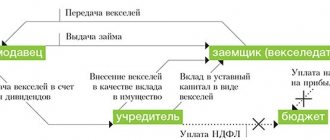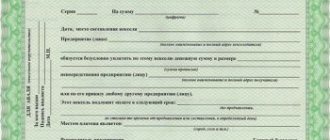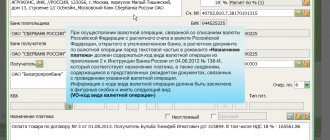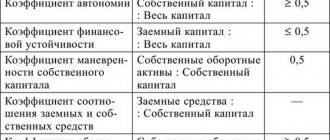What is a bill of exchange and why is it needed?
This debt document is paid at the end of the term. A person can use such paper to pay for goods or transfer it to another.
Often bills of exchange are used for mutual settlements between subsidiaries of the same holding company, so as not to transfer money between their companies and not pay taxes. If a business cannot pay suppliers or employees (for example, when accounts are garnished), it can write a promissory note to continue operating.
There are 4 options for payment terms:
- to a specific date;
- by the time of compilation;
- when presented;
- by the time of presentation.
If the time of return is tied to the date of presentation, the issued financial document is sold at par upon issue, but it indicates interest that accrues until the return date. In other cases, when issued, such a receipt costs less than its face value, which is determined by the amount of interest.
Concept of bill of exchange
In the modern world, everything new is well forgotten old.
This rule also applies to the concept of “bill”. In past centuries, bills of exchange were actively used by both individuals and enterprises and government agencies. During the Soviet Union, the majority of the population knew about bills only from works of fiction. Today, this financial document has again found use in many countries of the post-Soviet space. Definition 1
A bill of exchange is a type of security that contains an unconditional obligation of the debtor to pay the holder of the bill within a specified period the amount of money specified in the bill.
At its core, a bill of exchange is an ordinary promissory note. But since this is a security, it has a strictly defined type and certain degrees of protection. As securities, bills of exchange are circulated on the securities market. This means that they can be sold, purchased, exchanged. Bills of exchange can be paid for or used as a deposit.
Finished works on a similar topic
- Coursework Bills of enterprises 450 rub.
- Abstract Bills of exchange of enterprises 280 rub.
- Test work Bills of exchange of enterprises 190 rub.
Receive completed work or specialist advice on your educational project Find out the cost
We know that depending on the characteristics of the issuance and application of bills of exchange, there are:
- internal,
- external,
- simple,
- transferable,
- credit,
- deposit,
- etc.
Release Features
If all the necessary attributes are present, then the bill does not have to be drawn up on stamp paper. However, there are special forms that can be ordered from a printing house or purchased from the treasury.
When selling a financial instrument, a transfer and acceptance certificate is drawn up. It specifies the details and describes the transaction under which it was issued.
Accounting for own bills
They are commodity and financial. The first are given as confirmation that the buyer owes the supplier money for the goods. The second is when the subject of the transaction is the debt obligation itself. A financial promissory note can be either from the issuer (the legal entity that issued the promissory note) or from another company.
Typically, an organization issues such securities not at par value, but with a discount or interest. They are accounted for in the same way. The issuer's expenses (and the holder's income) of the discount variety will be the difference between the face value and the purchase price. If we are talking about an issued interest-bearing bill, the amount of interest.
Closing a bill of exchange
Useful articles
What is an endorsement on a bill of exchange and how to fill it out correctly
Often the maturity date is stated “at sight, but not before” a certain date. To pay off a debt, they draw up an act of presenting a promissory note and indicate all the details of the document, its denomination and the full amount that the drawer will pay. When the legal entity that issued the document has paid the debt, it transfers the receipt to the archive, along with the rest of the financial documentation.
Advance payment by bill of exchange
A loan letter is a convenient way to make an advance payment. Neither the supplier nor the buyer will fear that they will be deceived. An additional advantage is that the buyer will have time to make a profit, and the supplier can immediately sell the note and return the money for the goods.
Redistribution of funds
If two companies belong to the same holding company, and one does not have enough funds, and the other has more than it needs, the first can issue a second financial bill. This method is also convenient for covering internal debts of one subsidiary to another. But it is better to add a small discount to the document so that the tax office does not consider this operation as a gratuitous loan.
Who has the right to issue and use bills of exchange?
As a form of security established by law, bills of exchange (or rather, forms of bills of exchange) are issued at special enterprises by order of the country's central bank. They can then be transferred to commercial banks. A person who has a special permit - a certificate for carrying out such operations - is required to issue bills. Bill forms are strict reporting documents.
Need advice from a teacher in this subject area? Ask a question to the teacher and get an answer in 15 minutes! Ask a Question
In banks, a representative of an enterprise (legal entity) or an individual can draw up a bill of exchange in accordance with their goals. There is a strict procedure for filling out the bill of exchange form in compliance with the execution of all details in the state language.
§ 1. Procedure for issuing bills: conditions and legal features
If in chapter one of this study the general concepts and categories of bill law, its history, as well as the status of bill participants, in other words, its statics, were considered, then chapter two is devoted to the dynamics of bill legal relations, or bill circulation. Traditionally, bill circulation refers to transactions that entail the transfer of ownership of these documents. However, in our opinion, this is a somewhat narrow definition. Bill circulation (turnover), which is part of civil circulation, should be understood as the totality of all transactions with bills and regarding bills. It is in the process of bill circulation that, on the one hand, the specificity of bill of exchange legal regulation is revealed, and on the other hand, the rights and obligations of the persons participating in the bill obligation are realized. Such exercise of rights and obligations is the purpose of issuing this security. Therefore, the legislator regulates in sufficient detail not only the process of circulation of bills of exchange, but also the procedure for their issuance, which also has features that determine the specifics of the entire bill of exchange institution.
As P.P. noted. Tsitovich, “from other similar short-term loan securities, this paper differs in its origin - it is created by the will of private individuals.”[119] Thus, for the issuance (issuance) of bills of exchange, neither state registration nor obtaining any special permits (licenses), nor notification is required any organs. This determined that the release of these documents does not depend on the financial situation and type of activity of the drawers.
Exceptions exist for the Russian Federation, its constituent entities, municipalities, which can issue bills only in cases specifically provided for by federal law (as indicated in §6 Chapter I), as well as for banks and other credit organizations. In particular, by the Letter of the Central Bank of the Russian Federation “On amendments to the instructions of the Central Bank of the Russian Federation dated January 30, 1996. “On the procedure for regulating the activities of credit institutions” No. 315 dated 08.20.96. quantitative restrictions were introduced on the issue of bills of exchange by banks and credit organizations, namely: a risk standard for own bill obligations (N-13) was introduced, which establishes the possible ratio of bills of exchange and bank acceptances issued by these organizations in rubles and in foreign currency to their own funds (capital) credit organizations. The latter must ensure compliance with the specified standard in the amount of no more than 200%, starting from the balance sheet as of 10/01/96, and in the amount of no more than 100%, starting from the balance sheet as of 03/01/97. As for endorsements, avals and bill mediation, their size should be 50% of the amount of off-balance sheet obligations.
Arising from the needs of an individual case, each individual bill reflects a number of features unique to it. These features are expressed in the various grounds for issuing each document (purchase and sale transactions, loans, etc.), amounts, terms, variety of drawers and bill holders, guarantees of timely payment, etc. The negotiability of bills of exchange is in many ways similar to the negotiability of things determined by individual characteristics. This circumstance determines the fact that the Federal Law “On the Securities Market” No. 39-FZ dated April 22, 1996 cannot be applied to relations arising from a bill of exchange obligation, since this normative act only mediates relations arising in the process of issuance and circulation of issue-grade securities, regardless of their form and type of issuer. According to Art. 2 of this law, any securities that are simultaneously characterized by the following characteristics can be classified as issue-grade securities: 1) secure a set of property and non-property rights that are subject to certification, assignment and unconditional implementation in compliance with the form and procedure established by this law; 2) posted in releases; 3) have equal volumes and terms of exercise of rights within one issue, regardless of the time of acquisition. That is, the issue of securities is distinguished by its mass nature, the identity of the terms and amounts for which each copy is issued within one issue (this circumstance makes them a classic exchange commodity), in contrast to the issue of bills. These latter, usually having serial numbers, are placed depending on the demand (need) for them on the part of potential holders. With regard to the third parameter, it should be noted that the drawer is not limited in any way in the ability to establish any size and duration of the details of the amount and payment term, which, in most cases, determines the individualization of each specific bill.
There is an opinion that bills issued en masse (in a series of homogeneous documents) and providing for payment on them within a specified period of time or upon presentation of certain sums of money, regardless of their name and the presence of certain details, belong (according to a number of other characteristics) to the category bonds, instructions or bank certificates.[120] It seems that such a conclusion cannot be considered correct. Of course, there are common features among all securities. But as already noted, a bill of exchange is a strictly formal document and the power of bill of exchange law extends to all acts that have the form of a bill of exchange (the presence of a paper medium and a certain set of details) regardless of their number and other factors. Otherwise, the boundaries between different securities were blurred. In addition, the possibility of issuing blank bills, as well as transferring bills through blank endorsement (allowing these documents to be circulated like bearer securities) was a prerequisite for issuing such documents in series.
A specific feature of bills of exchange is the possibility of their repeated reproduction in several identical copies (samples). This phenomenon is called bill multiplicity. Art. 64 of the Regulations on bills of exchange stipulates that each such copy must be provided with a sequential number in the text itself: prima bill, second bill, third bill, quart bill, etc. (otherwise, such drafts are called first, second, third, fourth ). In the absence of this mark, each of the samples is considered as a separate (independent) bill. The law does not establish a limit on the number of copies - if necessary, there can be as many as you like. Each sample is a genuine bill of exchange and has the same legal force as the others. And at the same time, all together such samples represent one single bill. This involves a one-time payment of the amount specified in them, even if several such copies were presented to the payer (acceptor) on time at the same time. The reasons for issuing a draft in several samples may be different, for example: a) when the payer is in a place other than the place where the bill was drawn up, it becomes necessary to send him a document for acceptance; b) payment of the bill must be made in a place other than that where it was issued; c) in addition, the possibility of a bill of exchange existing exclusively in paper form increases the risk of its accidental destruction or loss. And, presumably, the circulation scheme for such a draft in several copies may be as follows: one sample is sent for acceptance, the second is put into circulation, the third is transferred for safekeeping to a certain person, etc.
If the bill of exchange does not directly indicate that it was issued in a legal form (that is, it is nikatom), then the holder of the bill may demand that several additional samples be issued to him at his expense. To do this, the remittor must contact the drawer directly. A different rule is established for subsequent holders, who in such a case are not given the right by the Regulations on bills of exchange to demand their issuance directly from the drawer - the interested holder of the bill must contact his direct endorser, who is obliged to assist him in relation to his endorser, etc., ascending to the drawer. The endorsers, whose signatures appear on the bill of exchange, are obliged to reproduce their endorsements on new copies. However, there are no guarantees that the holder’s request for the issuance of additional copies of the bill will be fulfilled (its fulfillment depends entirely on the will and good faith of the above-mentioned persons). In particular, the Regulations on bills of exchange do not provide for deadlines for fulfilling the obligations of endorsers to notify and assist their predecessors. And most importantly, it does not establish any sanctions in the event of the refusal of the drawer and endorsers to fulfill such an obligation.
At the same time, there may be several completely identical bills of exchange in circulation (both simple and transferable), having identical forms and identical details, but at the same time not being samples, but representing independent bills of exchange. Such documents, independent of each other, are called apuenami (from Italian appuntato - similar). Usually they occur when the drawer, instead of issuing one bill in the amount of, say, 1,000,000 rubles. issues 5 bills in the amount of 200,000 rubles each, to one person, on one day, in one place, etc., since the total amount may be inconvenient for further transfer (movement) of the bill.
Not only originals, but also copies (duplicates) of bills can be put into circulation. Copies are not equivalent to copies of the bill, for these latter are genuine. In addition, unlike samples, copies can be made from any bill of exchange. The right to make duplicates of these documents is granted to each of their holders. Instead of the original signatures of persons, a disclaimer (formula) is placed indicating that these signatures exist (for example, “signed by so-and-so”). The duplicate must indicate to what place it was brought: the holder of the bill, who compiled it, must put a dividing formula in the place where the bill ended (for example, “copy to this place”).
From the moment the copy is endorsed by its originator, the obligation to put original inscriptions on it by subsequent participants in the bill begins. The consequence of this is that the duplicate bill of exchange turns into a genuine bill of exchange [121] and, then, can be endorsed and avaliated in the general manner (Article 67 of the Regulations on Bills of Exchange). At the same time, if on the original document after the last endorsement made before the copy was made, there is a clause “from here on, endorsement is valid only on a copy” or any other equivalent formula, then the endorsement placed after that on the original is invalid. At the same time, it must be said that the payer can accept for acceptance only a genuine bill of exchange, in particular, that fragment of it that directly contains the text of the bill of exchange obligation.
If there are several copies (fragments) of a bill of exchange, the entire set is considered the main document. In practice, situations are possible when only a copy with part of the original bill of exchange is in circulation, while the other genuine part may be in another place (for example, a depository). Art. 68 of the Provisions on Bills of Exchange stipulates that in this case, the copy must indicate the person in whose hands the original document is located. This person is obliged to deliver the said fragment to the lawful holder of the copy. If this person refuses to do this, the holder of the bill may exercise the right to file a claim against the obligated persons (endorsers, avalists, etc.) only after certifying by protest that the original was not transferred to him, despite his demand. In this case, a problem arises caused by the fact that the “Fundamentals of the legislation of the Russian Federation on notaries” No. 4462-1 of 02/11/93[122] This form of protest is not provided for at all. Therefore, to protect the rights of the bill holder, in particular, two ways are possible: 1) refusal of the potential bill holder to accept part of this document and demand either the bill in all its fragments or alternative satisfaction; 2) making additions to Art. 95 of the above law on the possibility of making a protest in the failure to transfer to the legal holder a copy or original of a bill.
Every bill is a formal document. And an act that does not meet the requirements of Art. Art. 1, 75 of the Provisions on Bills of Exchange cannot be recognized as such. Taking this circumstance into account, certain amendments, erasures, and deletions become of great importance in cases where they change or destroy the necessary elements of the bill of exchange. At the same time, in some cases, such changes may be necessary. As a result of this, Art. 69 and art. 77 The provisions on bills allow for the introduction of certain amendments to the contents of the bill, which include changes and deletions. The question arises: who can make changes to the bill of exchange? Part 2 art. 26 of the Provisions on Bills of Exchange establishes that the acceptor is not authorized to take such actions; however, just like an avalist (for for an avalist, usually only a signature is enough). From an analysis of the content of the Regulations on bills of exchange, we can conclude that only the drawer (drawer) and endorsers can be the persons who have the right to make amendments and thereby transform the bill of exchange obligation. As for the changes that these persons can make, then in relation to the drawer (drawer), it can be assumed that he has the right to make any changes relating to any details. However, clause 5.3 of the Recommendations establishes that no corrections to the bill amount are allowed, even those stipulated by the signature of the drawer. And this is quite reasonable, since allowing such an amendment to be made is very risky, due to the fact that when the bill is circulated, it will then be impossible to establish at what point and by whom such a change was made. Changes made by endorsers, in accordance with Part 3 of Art. 23 and Art. 34 Provisions on bills of exchange can relate to only one detail - the payment period, which can be reduced by them in bills of exchange with a period of “at sight” or “in such and such a time from sight”.
Regulations on bills of exchange, art. 69, establishes that in case of changes to the text of the bill, persons who signed after this change are responsible in accordance with the content of the changed text; persons who put their signatures before respond in accordance with the content of the original text. Therefore, in order to eliminate abuses, it seems advisable to provide, firstly, that the signature of the authorized person should be one and follow the amendment, and not be before it. The presence of unspecified changes, amendments, additions, as well as the presence of erasures cast doubt on the validity of the bill, since they are its visible defects. This is also important when protesting a bill of exchange. According to Art. 45 “Fundamentals of the legislation of the Russian Federation on notaries” No. 4462-1 dated February 11, 1993[123], notaries have no right to accept documents that have unspecified corrections for performing notarial acts. Secondly, such an amendment can be made not just anywhere on the bill, but in a certain sequence: only after the inscriptions and reservations of the previous holders. This rule is necessary to eliminate objections that might concern accidental and unimportant corrections.
With regard to strike-throughs, it should be said that they can be made by any participant in the bill. Such deletion has the effect of terminating the obligation of the person whose inscription is destroyed.
One of the conditions for the validity of the bill is payment by tax. In accordance with Art. 1 of the 1930 Stamp Duty Convention on Bills of Exchange and Promissory Notes, its member countries have undertaken to provide in their legislation that the validity of the obligations assumed by the parties to a bill of exchange or the exercise of rights arising therefrom may be subject to compliance with the provisions on stamp duty. collection However, in Russia this fee was introduced only in 1991. Resolution of the Council of Ministers of the RSFSR “On stamp duty rates for transactions with securities” No. 87 dated 02/08/91[124], which established the stamp duty rate in the amount of 1 ruble. with each 1000 rub. with its subsequent transfer to the republican budget of the RSFSR. A few months later, stamp duty was replaced by a system of taxation of income (interest and discount) on the bill. Currently, the Federal Law “On Amendments and Additions to the Law of the Russian Federation “On Profit Tax of Enterprises and Organizations” No. 227-FZ dated December 31, 1995[125] A general tax rate for all types of bills has been established - 15%. However, it seems that this system was flawed from the very beginning. To understand how this is expressed, it is necessary to make a brief overview of the varieties, as well as some of the features of the bill tax of pre-revolutionary Russia.
Thus, all bills of exchange were subject to stamp duty, regardless of their name (solo, transit, etc.). According to Art. 80 of the “Charter on Stamp Duty” dated June 10, 1900[126], payment of papers, acts and documents subject to this tax was made in several ways:
1) By presenting them on stamped paper (it makes no difference, on one or several sheets), the value of which corresponded to the salary of the fee due from the document being paid. Stamp paper, otherwise known as promissory note, was used to write personal debt obligations. And the tax paid on the use of this paper was a proportional fee, commensurate with the amount of the obligation. In particular, in Russia there were 25 levels, which corresponded to 25 types (merits) of bill paper: the lowest - up to 50 rubles. inclusive, second - from 50 rubles. up to 100 rub. inclusive... and the highest - maximum from 40,000 to 50,000 rubles;
2) By attaching a stamp paper in the amount of stamp duty due to this act, drawn up either on plain paper or on a stamp paper, but of improper denomination;
3) By imposing on papers, acts and documents written on plain or stamped paper of improper value, official stamps, the value of which, in full or in addition to the stamped paper, corresponded to the salary of the fee due on the paid paper;
4) Cash.
Thus, there were three methods of taxation of bills: one main, general one - the use of stamped bill paper for writing bills. This tax was levied on all bills of exchange within the Empire. The other two are exceptional: paying the tax directly to the Treasury or spending the same amount of stamps (via sticker and redemption). These methods were used in addition to and in replacement of the first method for foreign bills. For failure to pay the bill of exchange, violators were threatened with a fine.
As for the main features of this fee, we would like to note the versatility, ease of collection, as well as the availability of stamp details for every capable individual and legal entities wishing to enter into a bill of exchange (stamp paper and stamps could be purchased at any post office everywhere) . This resulted in a huge volume of bill transactions and a significant speed of turnover of these securities not only within the country, but also abroad. This, in turn, reduced the need to issue cash and provided a stable income to the state treasury. A completely different situation is observed at the moment: the process of paying taxes involves carrying out payment orders through a bank, which entails additional complexity for individuals. Another feature of the bill tax of that time was that it was levied on the bill amount only once - when drawing up the document and its burden was borne exclusively by the drawer (drawer). Now this tax is levied on every transaction that entails the transfer of ownership of a bill, and therefore, when it is circulated, it can be levied countless times. This in itself is an obstacle to the development of bill circulation, since it contributes to solving tactical problems (replenishing the budget and collecting taxes) rather than strategic ones (reducing the number of non-payments and improving the economy).
The absence of a uniform stamp (promissory note) paper for all subjects has led to the fact that, from the point of view of the paper medium (as an element of the form) in the Russian Federation, today there are (conditionally) two large flows. The basis of the first of them is the Decree of the Government of the Russian Federation “On the registration of mutual debt of enterprises and organizations with bills of a single sample and the development of bill circulation” No. 1094 of September 26, 1994. In accordance with this act, uniform forms of promissory notes and bills of exchange were introduced on the territory of Russia for use in economic transactions. These forms are issued by the Ministry of Finance of the Russian Federation and are then sold through the system of institutions of the Central Bank and commercial banks at a single price. The introduction of such forms into circulation was partly caused by the needs of bill circulation (requirements for the standardization of such money substitutes, reducing the costs of their production, etc.), partly by the interest of the Central Bank in the rediscounting of bills of the same form. The disadvantage of this act is that it did not reflect the principle of unity of bills and bill circulation, since according to clause 7, such forms were available only to legal entities. In particular, in connection with this circumstance, Art. 8 of the Federal Law “On Bills of Exchange and Promissory Note”, the Government of the Russian Federation was asked to bring its regulations into compliance with this law.
Since most of the provisions of the above-mentioned Decree of the Government of the Russian Federation are advisory in nature, for a number of reasons many legal entities (mainly banks) preferred another option, namely, the independent production of bill forms. This mass of bills constitutes the second bill flow, which (unlike the first) is characterized by countless fragmentation, as well as a variety of appearance and form.
The production of forms of securities such as bills of exchange is not subject to licensing by the Ministry of Finance of the Russian Federation, in contrast to forms of shares, bonds, deposit and savings certificates, etc., whose release into circulation requires registration (and which are subject to the Decree of the Government of the Russian Federation “On the streamlining production of securities forms in the Russian Federation" No. 376 dated 06/03/92 and whose production is regulated by the "Regulations on the procedure and conditions for issuing licenses for the production and import into the territory of the Russian Federation of securities forms", approved by Letter of the Ministry of Finance of the Russian Federation No. 05-01-04 dated September 17, 1992 [127] as amended by Letters dated 93, 94). However, at present, when counterfeiting of bills has become widespread and there is a high risk of holders receiving fictitious bills, and debtors - paying for such papers, it becomes necessary for the latter, when issuing bills, to use forms equipped with security elements (watermarks) as a carrier. , special paints, printing methods, etc.).
Any bill of exchange, in order for it to come into force in relation to the first purchaser, must be issued (transferred) to him by the drawer. The moment of issuance of a bill of exchange is expressed in its delivery (transfer) from the drawer of a promissory note or the drawer of a bill of exchange to the first purchaser (remitee). The bill is considered delivered from the moment it actually comes into the possession of the first purchaser (paragraph 2, clause 1, article 224 of the Civil Code of the Russian Federation), unless it turns out that in reality there was no fact of issue, for example, the bill was stolen or forcibly taken away. However, in cases where the drawer issued this document under threat, coercion or under the influence of other circumstances distorting his will or expression of will, for a third party to whom this act was then transferred, this is not obvious and, therefore, does not have any effect on him no legal significance. Thus, a situation arises when, on the one hand, the one who formally correctly issued the bill of exchange is subject to protection, but the agreement underlying the issuance of this document is invalid and, on the other hand, the third party who subsequently received this bill of exchange must also be protected moved.
According to the general rule, paragraph 2 of Art. 147 of the Civil Code of the Russian Federation, refusal to fulfill an obligation certified by a security, citing the absence of a basis for such an obligation or its invalidity, is not allowed. This is confirmed by Art. 17 of the Provisions on Bills of Exchange, which establishes that obligated persons cannot oppose the holder of a bill of exchange with objections based on their personal relationships (that is, objections arising from powers outside the bill of exchange obligation). The exception is the case when the holder of the bill, upon receipt of the bill, acted deliberately to the detriment of the debtor. Then, based on Art. 179 of the Civil Code of the Russian Federation, in the event that the court recognizes as invalid a transaction made under the influence of deception, violence, threat, malicious agreement between a representative of one party and the other party, as well as a transaction that the drawer was forced to make as a result of a combination of difficult circumstances on conditions extremely unfavorable for himself, than the other party took advantage of it (enslaving transaction), the drawer of the bill is returned everything received under the transaction (that is, the bill itself), and the real damage caused to him is also compensated.
As for other persons, endorsers, to whom the bill was then transferred, then Part 2 of Art. 16 of the Bill of Exchange Regulations establishes that if someone is deprived of possession of a bill of exchange due to any event, then the person in whose possession the bill of exchange is located, and who bases his right on a continuous series of endorsements, is obliged to give the bill of exchange only if it acquired it in bad faith or, in acquiring it, committed gross negligence. In other words, any person can only have rights under a bill when he acquired it in good faith, that is, he did not know and could not know that the bill was not legally “purely” issued by the drawer, but was put into circulation against his will, and also unless his actions were grossly negligent. At the same time, the presence of the bill of exchange in the possession of the bill holder presupposes the fact of its contractual issuance, which does not require any evidence from the latter. And the dispute in this case will not be about fact, but about law. Thus, as noted by O.S. Ioffe, bill legislation does not provide for complete (material) abstraction of a bill, excluding any reference to the absence of a basis, but only relative (procedural), allowing objections based on bad faith or gross negligence of the bill holder.[128]
Conscientious ownership of the bill and the absence of gross negligence at the time of its acquisition, as conditions for the entry into force of this document, are important not only in relation to the first acquirer (remitee), but also in relation to each subsequent acquirer of this security. Based on the foregoing, we can conclude that priority is given to the needs of bill circulation and the interests of bona fide purchasers.
With the transfer of the bill to the first acquirer (remitee), the latter becomes its owner (holder), at the same time acquiring the right to perform with this document all actions that can be taken in general in relation to any other property.
[119] Tsitovich P.P. On the issue of the bill of exchange charter (answer to A. Knierim). St. Petersburg Type. A. Demakova. 1895. P.3.
[120] Belov V. The practice of issuing bills by commercial banks. // Business and banks. 1995. No. 36.
[121] Regulations on bills of exchange, part 3. Art. 67, reads verbatim as follows: “a copy may be endorsed and endorsed in the same manner and with the same consequences as the original.” However, it is advisable to assume that this is not entirely accurate, since a copy can neither be endorsed nor avaliable. From the moment the first genuine endorsement appeared on it, we have before us a fragment of a genuine bill of exchange.
[122] Gazette of the Congress of People's Deputies of the Russian Federation and the Supreme Council of the Russian Federation. 1993. No. 10. Art. 357.
[123] Further in the text Basics of notaries.
[124] Collection of Resolutions of the Government of the RSFSR. 1991. No. 11. Art. 155.
[125] Collection of legislation of the Russian Federation. 1996. No. 1. Art. 20.
[126] New Statute on Stamp Duty with instructions from the Minister of Finance on the procedure for paying stamp duty on papers, acts and documents. With rules, circulars, explanations of the Ministry of Finance and an alphabetical index. 3rd ed., unofficial. St. Petersburg 1902.
[127] Bulletin of regulatory acts of ministries and departments of the Russian Federation. 1993. No. 1.
[128] Ioffe O.S. Law of obligations. M: "Legal Literature". 1975. P.687.








